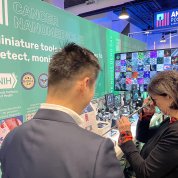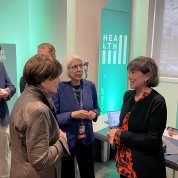American Possibilities
Several ICs Put on Show at White House Demo Day
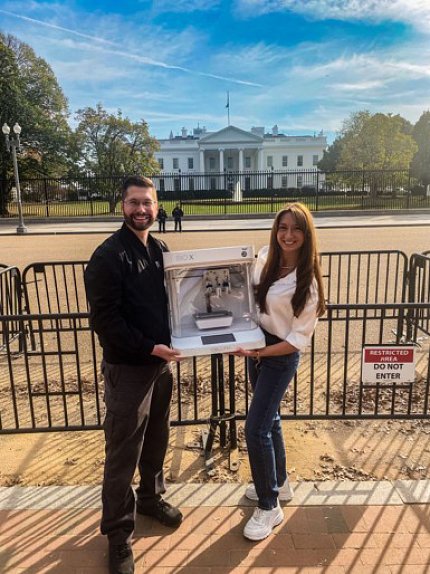
Innovative research from across NIH was on full display at the American Possibilities: 2023 White House Demo Day, an event hosted late last year by the White House Office of Science and Technology Policy.
The event showcased innovations from 40 exhibitors supported by federal investment. Topics included energy, national security, artificial intelligence, climate and health.
NCATS scientists Kristy Derr and Shayne Frebert donned their white lab coats to demonstrate their 3-D tissue bioprinting capabilities by printing a red, white and blue lattice resembling an American flag. The booth drew large crowds and long lines up until the event ended.
“It is such an honor to be invited to an event like this,” said Derr. “It was very rewarding to see how many people were interested and excited about our work. It made me feel so proud to be a part of such an innovative and impressive group.”
Through the process of 3-D tissue bioprinting, researchers like Derr and Frebert are creating models that mimic the structure and functionality of tissues in our bodies for drug screening and disease research. The goal is to better predict which treatments tested in the lab will be successful in clinical trials in people.
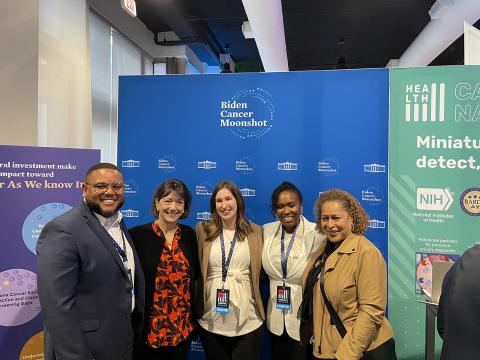
“Everyone was amazed with how this technology is currently being used,” said Frebert. “The video presentation we had at our booth, which included the ‘American Flag’ printing process, really helped us gather attendees so that we could talk more about the great work we’ve been doing.”
Research collaborations with scientists from NIH, academic institutions and industry have been key to testing and validating the technology as a solution for both studying and finding treatments for diseases affecting our skin, lungs, eyes and other organs. Learn more at ncats.nih.gov/research/research-activities/bioprinting.
NEI representatives showed off a commercially available optical coherence tomography (OCT) retinal imaging device. Booth visitors had images of their retinas taken.
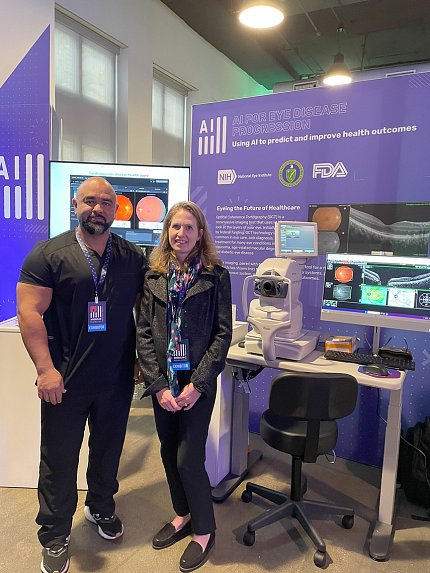
OCT is a revolutionary imaging technology, developed with federal funding dating back to the 1990s. The technology has been universally adopted by ophthalmologists and optometrists over the past 10 years and has changed how they diagnose and monitor patients with eye disease. Based on recent studies, OCT has potential to diagnose and monitor many systemic diseases, including Alzheimer’s disease, cardiac disease, psychiatric disease, diabetes and more.
“President Biden joined us at the end and interviewed several of the exhibitors,” said Kerry Goetz, associate director, NEI Office of Data Science and Health Informatics. “If I had to explain the event in a sentence it was ‘an adult science fair judged by the President.’ Our exhibit highlighted the potential to use retina imaging and OCT to predict everything from cardiovascular health to overall wellness. We used a Maestro2, a device that can capture high-quality images in less than a minute with the push of a button. Guests were invited to try it out at the event and learn about our plan to add these types of images to the All of Us Research Program to ensure diversity in future uses.”
In addition to NCATS and NEI, technology supported by the National Cancer Insitute, National Institute on Deafness and Other Communication Disorders and NIH’s BRAIN Initiative was presented.

